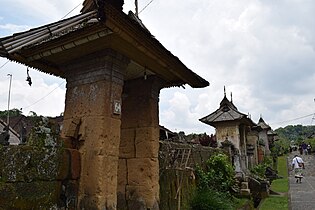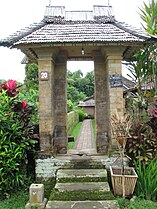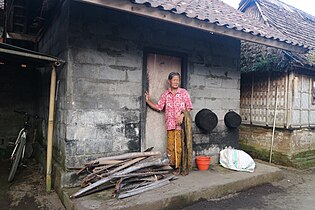
Ubud is a town on the Indonesian island of Bali in Ubud District, located amongst rice paddies and steep ravines in the central foothills of the Gianyar regency. Promoted as an arts and culture centre, it has developed a large tourism industry. It forms a northern part of the Greater Denpasar metropolitan area.

Uluwatu Temple is a Balinese Hindu temple located on the south-western tip of the Bukit Peninsula in Uluwatu, Badung Regency, Bali, Indonesia. It is the only Balinese sea temple that is also one of the nine directional temples.

Bangli Regency is the one and only landlocked regency (kabupaten) of Bali, Indonesia.

Mandala Suci Wenara Wana, also known as Ubud Monkey Forest, is a sanctuary located in Padangtegal, Ubud, Bali, Indonesia.

The Bali Aga, Baliaga, or Bali Mula are the indigenous people of Bali. Linguistically they are an Austronesian people. Bali Aga people are predominantly located in the eastern part of the island, in Bangli especially the mountains Kintamani, East Buleleng, West Buleleng and East Karangasem, but they can also be found in north-western and central regions. The term Bali Aga or Bali Pégunungan is regarded as an insult with an additional meaning of "the mountain people that are fools"; therefore, they prefer the term Bali Mula instead.

Batuan is a village in Bali, Indonesia. It is noted for its artwork and style of painting which originated in the village in the 1930s and has since emerged into a major Balinese artistic style, known as a Batuan painting. It is a major painting center and contains a number of art galleries and cooperative art societies which have played a key role in promoting the art of Batuan. The village is also known for its performance of the ancient Gambuh dance, performed every Full Moon day.

Pura Dalem Agung Padangtegal, or Padangtegal Great Temple of Death, is one of three Hindu temples making up a temple complex located in the Sacred Monkey Forest Sanctuary – commonly called the "Ubud Monkey Forest" – of Padangtegal, Ubud, Bali, Indonesia.

Pura Ulun Danu Batur is a Hindu Balinese temple located on the island of Bali, Indonesia. As one of the Pura Kahyangan Jagat, Pura Ulun Danu Batur is one of the most important temples in Bali which acted as the maintainer of harmony and stability of the entire island. Pura Ulun Danu Batur represents the direction of the North and is dedicated to the god Vishnu and the local goddess Dewi Danu, goddess of Lake Batur, the largest lake in Bali. Following the destruction of the original temple compound, the temple was relocated and rebuilt in 1926. The temple, along with 3 other sites in Bali, form the Cultural Landscape of Bali Province which was inscribed as a World Heritage Site by UNESCO in 2012.

A Pura is a Balinese Hindu temple and the place of worship for adherents of Balinese Hinduism in Indonesia. Puras are built following rules, style, guidance, and rituals found in Balinese architecture. Most puras are found on the island of Bali, where Hinduism is the predominant religion; however many puras exist in other parts of Indonesia where significant numbers of Balinese people reside. Mother Temple of Besakih is the most important, largest, and holiest temple in Bali. Many Puras have been built in Bali, leading it to be titled "the Island of a Thousand Puras".
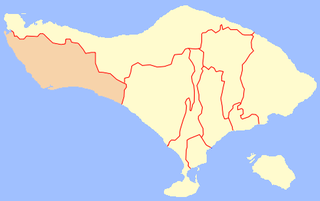
Jembrana Regency is a regency (kabupaten) in the southwest of Bali, Indonesia. It has an area of 841.8 km2 and had a population of 261,638 at the 2010 Census and 317,064 at the 2020 Census; the official estimate as at mid 2022 was 327,850. Its regency seat is the town of Negara.
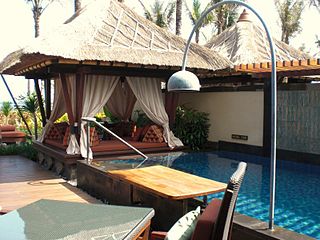
Balinese architecture is a vernacular architecture tradition of Balinese people that inhabits the volcanic island of Bali, Indonesia. Balinese architecture is a centuries-old architectural tradition influenced by Balinese culture developed from Hindu influences through ancient Javanese intermediary, as well as pre-Hindu elements of native Balinese architecture.

Trunyan or Terunyan is a Balinese village (banjar) located on the eastern shore of Lake Batur, a caldera lake in Bangli Regency, central Bali, Indonesia. The village is one of the most notable homes of the Bali Aga people, the others being the villages of Tenganan and Sambiran. Trunyan is notable for its peculiar treatment of dead bodies, in which they are placed openly on the ground, simply covered with cloth and bamboo canopies, and left to decompose. The influence of a nearby tree is said to remove the putrid smell of the corpses.
Pura Griya Sakti is a Balinese Hindu temple located in the village of Manuaba, Kenderan administrative village, Tegalalang subdistrict, Gianyar Regency, Bali. The district is known for its woodcarving and its terraced rice field. The small village of Manuaba is about 4 km north of Kenderan or about 2.5 km southwest of the town of Tampaksiring with its famed Gunung Kawi temple. Pura Griya Sakti is the main temple of a powerful Brahman caste in the area.

Pura ParahyanganAgung Jagatkarta often referred to simply as Pura Parahyangan is a Hindu temple of Nusantara located in Ciapus village, Tamansari subdistrict, Bogor Regency, West Java, Indonesia.

Pura Kehen is a Balinese Hindu temple located in Cempaga, Bangli Regency, Bali. The temple is set on the foot of a wooded hill, about 2 kilometres north of the town center. Established at least in the 13th-century, Pura Kehen was the royal temple of the Bangli Kingdom, now the Regency of Bangli.
Pura Dalem Sakenan is a pura located at the north-western shore of Serangan, a small island about 10 kilometres south of Denpasar, Bali. Pura Dalem Sakenan is dedicated to [rambut sedhana] and is associated with prosperity. Pura Dalem Sakenan is the focus temple of the 210-day Piodalan festival where in the past processions of pilgrims visited the island on foot or by traditional colorful wooden boats called jukung. With the construction of the bridge connecting the Serangan island with Bali as well as the reclamation of the island, the use of colorful jukung for pilgrimage has died out.
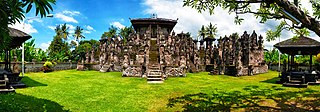
Pura Beji Sangsit is a Balinese temple or pura located in Sangsit, Buleleng, on the island of Bali, Indonesia. The village of Sangsit is located around 8 kilometres east of Singaraja. Pura Beji is dedicated to the rice goddess Dewi Sri, and is revered especially by the farmers around the area. Pura Beji is an example of a stereotypical northern Balinese architecture with its relatively heavier decorations than it is southern Balinese counterpart, and its typical foliage-like carvings.
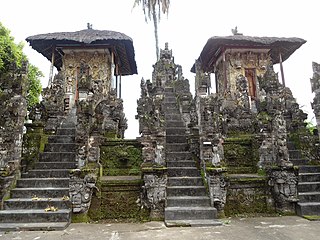
Pura Dalem Segara Madhu also known as Pura Dalem Jagaraga is a northern Balinese Hindu temple or pura located in the village of Jagaraga, Buleleng in northern Bali. It is about 11 km east of Singaraja. The village of Jagaraga is known historically as the place where the Dutch colonial government witnesses puputan or Balinese mass-suicide following their military attack on the kingdom of Bali in 1849. Pura Dalem Segara Madhu is known for its intensive wall decoration typical of northern Balinese architecture and for its unique western-influenced reliefs featuring early 20th-century airplanes and automobiles.
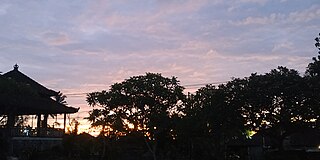
Budakeling or Bude Keling is a village located in Bebandem District in Bali, Indonesia. The village is 617 mile long. The postal code of Budakeling is 80861.
The Kingdom of Mengwi was one of the Kingdomship of Bali that was established in the 18th century. The founder of this kingdom was I Gusti Agung Made Agung, with the title I Gusti Agung Bima Sakti. The Kingdom of Mengwi came to an end after being defeated by its own kin, Badung, and its allies in 1891.



